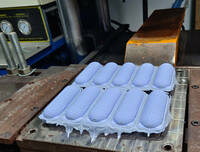Categories
Tags
-
#SEO
#One-Color Closed Ink Cup Pad Printer
#Carbide Ring for Pad Printing Ink Cups
#Motocross Goggles
#At GAIA
#we specialize in the field of flexible packaging
#offering a wide range of innovative and high-quality packaging solutions.
#custom CNC milling services
#Ceramic Lamp Holder
#Silicone Breast Pump Clamp
#Wire Electric Motor Automatic Coil Winding Machine
#skiing helmets
#Ground Coffee Bags
#Four Color Pad Printing Machine
#Precision stamping
#Deep drawing
#Silicone Molding
#丝印机
#Ben Wa Balls for Women
Archives
Silicone Molding: The Ideal Solution for Flexible and Durable
-
In the world of product development and prototyping, silicone molding has emerged as a versatile and cost-effective manufacturing method, especially for producing small batches of highly detailed, durable, and flexible parts. Whether you're building consumer products, medical devices, or industrial components, silicone molding offers unmatched flexibility, material performance, and surface finish.
What is Silicone Molding?
Silicone molding is a soft tooling process that uses silicone rubber to create molds from a master pattern. Once the mold is formed, it is used to cast parts in materials like urethane, resins, or silicone rubbers, producing highly accurate replicas of the original prototype. This process is often referred to as vacuum casting or urethane casting when using polyurethane materials.
The method is ideal for low-volume production, bridge tooling, and pre-production testing, allowing companies to validate design, functionality, and material performance before investing in expensive steel molds for mass production.
Advantages of Silicone Molding
-
Cost-Effective for Low Volumes
Unlike injection molding, which requires expensive tooling, silicone molds are far more affordable and can produce up to 25–50 parts per mold—ideal for rapid prototyping or small production runs. -
High-Quality Surface Finish
Silicone molds capture fine details from the master model, resulting in smooth, production-quality parts with minimal post-processing. -
Material Versatility
Silicone molding supports a wide range of casting materials, including soft elastomers, rigid plastics, and clear resins, making it suitable for diverse applications like medical device prototyping, automotive components, and consumer product testing. -
Speed and Flexibility
The entire process—from master pattern creation (often via CNC machining or 3D printing) to mold making and part casting—can be completed in just days, allowing for faster design validation and iteration. -
Ideal for Functional Testing
The casted parts can mimic the mechanical and thermal properties of final production materials, making functional prototyping and user testing more realistic and informative.
Applications of Silicone Molding
Silicone molding is widely used across industries for:
-
Medical device prototypes (due to biocompatible material options)
-
Consumer electronics enclosures
-
Automotive interior and trim components
-
Wearable technology prototypes
-
Custom housings and gaskets
Choosing a Silicone Molding Service Provider
When selecting a silicone molding company, look for one that offers in-house master pattern production, vacuum casting capabilities, and material consultation. Experience in handling both rigid and flexible materials is crucial for achieving high-quality results.
Whether you're launching a new product or refining an existing design, silicone molding gives you the ability to produce realistic, functional prototypes quickly and affordably—bridging the gap between prototyping and production.
-
